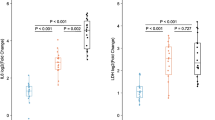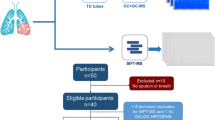Summary
The fast development of analytical techniques in the field of gas analysis can be compared to that of computers during the last two decades. Not only speed but also sensitivity of analysis has been greatly improved, sometimes by a factor of 100 or more. This technological development has fostered the analysis of exhaled breath. Since this can be done in real-time, very fast biological processes can be monitored. Also simulation and modelling of haemodynamics and lung mechanics become possible. During the next decade we will see miniaturized equipment (of the size of a cigarette box) appear. Here we review and illustrate the rich diversity of compounds observed in exhaled breath with a particular focus on lung cancer patients. Each of the many volatile compounds has its own particular biochemical background, and cell types with different genetic background have been shown to have a different pattern of released and consumed volatile compounds. Nevertheless we still lack an understanding, if and how genetic alterations, which are seen as the underlying cause of the transformation process, control the VOC phenotype observed in patients or cancer cell lines. The concentration pattern of volatile compounds in exhaled breath may be used in the future for phenotyping individuals in large-scale screening approaches. Also changes in VOC patterns may provide disease-relevant information (e.g. on the activity of metabolizing enzymes). Future applications will also include the follow-up of exogenous compounds which are ingested or inhaled as drugs, food components or components in cigarette smoke and metabolic products of these compounds.
Similar content being viewed by others
Abbreviations
- SPME:
-
solid phase microextraction
- TD:
-
thermodesorption
- GCMS:
-
gas chromatography mass spectrometry
- PTR-MS:
-
proton-transfer-reaction mass spectrometry
- SIFT-MS:
-
selected ion flow tube mass spectrometry
- LOD:
-
limit of detection
- LOQ:
-
limit of quantification
- VOCs:
-
volatile organic compounds
References
Wistuba II, Gazdar AF, Minna JD. Molecular genetics of small cell lung carcinoma. Semin Oncol, 28(2 Suppl 4): 3–13, 2001
Sato M, Shames DS, Gazdar AF, Minna JD. A translational view of the molecular pathogenesis of lung cancer. J Thorac Oncol, 2(4): 327–343, 2007
Risch A, Plass C. Lung cancer epigenetics and genetics. Int J Cancer, 123(1): 1–7, 2008
Henschke CI, Yankelevitz DF, Libby DM, Pasmantier MW, Smith JP, Miettinen OS. Survival of patients with stage I lung cancer detected on CT screening. N Engl J Med, 355(17): 1763–1771, 2006
Infante M, Cavuto S, Lutman FR, Brambilla G, Chiesa G, Ceresoli G, Passera E, Angeli E, Chiarenza M, Aranzulla G, Cariboni U, Errico V, Inzirillo F, Bottoni E, Voulaz E, Alloisio M, Destro A, Roncalli M, Santoro A, Ravasi G. A randomized study of lung cancer screening with spiral computed tomography: three-year results from the DANTE trial. Am J Respir Crit Care Med, 180(5): 445–453, 2009
Bach PB, Jett JR, Pastorino U, Tockman MS, Swensen SJ, Begg CB. Computed tomography screening and lung cancer outcomes. Jama, 297(9): 953–961, 2007
Bajtarevic A, Ager C, Pienz M, Klieber M, Schwarz K, Ligor M, Ligor T, Filipiak W, Denz H, Fiegl M, Hilbe W, Weiss W, Lukas P, Jamnig H, Hackl M, Haidenberger A, Buszewski B, Miekisch W, Schubert J, Amann A. Noninvasive detection of lung cancer by analysis of exhaled breath. BMC Cancer, 9(1): 348, 2009
Ligor M, Ligor T, Bajtarevic A, Ager C, Pienz M, Klieber M, Denz H, Fiegl M, Hilbe W, Weiss W, Lukas P, Jamnig H, Hackl M, Buszewski B, Miekisch W, Schubert J, Amann A. Determination of volatile organic compounds appearing in exhaled breath of lung cancer patients by solid phase microextraction and gas chromatography mass spectrometry. Clin Chem Lab Med, 47: 550–560, 2009
Phillips M, Cataneo RN, Saunders C, Hope P, Schmitt P, Wai J. Volatile biomarkers in the breath of women with breast cancer. J Breath Res, 4(2): 026003, 2010
Miekisch W, Schubert JK, Noeldge-Schomburg GF. From highly sophisticated analytical techniques to life-saving diagnostics: technical developments in breath analysis. Trends in Anal Chem, 25(7): 665–673, 2006
Amann A, Spanel P, Smith D. Breath analysis: the approach towards clinical applications. Mini Rev Med Chem, 7: 115–129, 2007
Poli D, Carbognani P, Corradi M, Goldoni M, Acampa O, Balbi B, Bianchi L, Rusca M, Mutti A. Exhaled volatile organic compounds in patients with non-small cell lung cancer: cross sectional and nested short-term follow-up study. Respir Res, 6(1): 71, 2005
Schubert J, Miekisch W, Birken T, Geiger K, Nöldge-Schomburg G. Impact of inspired substance concentrations onto results of breath analysis in mechanically ventilated patients. Biomarkers, 10: 138–152, 2005
Schubert J, Miekisch W, Nöldge-Schomburg G. VOC breath markers in critically ill patients: potentials and limitations. In: Amann A, Smith D (eds) Breath analysis for clinical diagnosis and therapeutic monitoring. World Scientific, Singapore, pp. 267–292, 2005
Schubert JK, Miekisch W, Geiger K, Noldge-Schomburg GF. Breath analysis in critically ill patients: potential and limitations. Expert Rev Mol Diagn, 4(5): 619–629, 2004
Miekisch W, Schubert JK, Noeldge-Schomburg GF. Diagnostic potential of breath analysis – focus on volatile organic compounds. Clin Chim Acta, 347(1–2): 25–39, 2004
Ligor T, Ligor M, Amann A, Ager C, Bachler M, Dzien A, Buszewski B. The analysis of healthy volunteers' exhaled breath by the use of solid-phase microextraction and GC-MS. J Breath Res, 2: 046006, 2008
Herbig J, Müller M, Schallhart S, Titzmann T, Graus M, Hansel A. On-line breath analysis with PTR-TOF. J Breath Res, 3: 027004 (10pp), 2009
King J, Kupferthaler A, Unterkofler K, Koc H, Teschl S, Miekisch W, Schubert J, Hitnerhuber H, Amann A. Isoprene and acetone concentration profiles during exercise at an ergometer. J Breath Res, 3: 027006 (16pp), 2009
King J, Mochalski P, Kupferthaler A, Unterkofler K, Filipiak W, Teschl S, Teschl G, Hinterhuber H, Amann A. Dynamic profiles of volatile organic compounds in exhaled breath as determined by a coupled PTR-MS/GC-MS study. Physiol Meas, 31(9): 1169–1184, 2010
Smith D, Spanel P. Selected ion flow tube mass spectrometry (SIFT-MS) for on-line trace gas analysis. Mass Spectrom Rev, 24(5): 661–700, 2005
Ruzsanyi V, Baumbach JI, Sielemann S, Litterst P, Westhoff M, Freitag L. Detection of human metabolites using multi-capillary columns coupled to ion mobility spectrometers. J Chromatogr A, 1084(1–2): 145–151, 2005
Baumbach JI. Ion mobility spectrometry coupled with multi-capillary columns for metabolic profiling of human breath. J Breath Res, 3: 034001, 2009
von Basum G, Halmer D, Hering P, Mürtz M. Laser spectroscopic on-line monitoring of exhaled trace gases. In: Amann A, Smith D, (eds) Breath analysis for clinical diagnosis and therapeutic monitoring. World Scientific, Singapore, pp. 67–74, 2005
Wysocki G, McCurdy M, So S, Roller C, Tittel F. Exhaled human breath analysis with quantum cascade laser-based gas sensors. In: Amann A, Smith D (eds) Breath analysis for clinical diagnosis and therapeutic monitoring. World Scientific, Singapore, pp. 75–84, 2005
Fritsch T, Hering P, Murtz M. Infrared laser spectrosopy for online recording of exhaled carbon monoxide – a progress report. J Breath Res, 1(1): 014002, 2007
Amann A, Telser S, Hofer L, Schmid A, Hinterhuber H. Breath gas as a biochemical probe in sleeping individuals. In: Amann A, Smith D (eds) Breath analysis for clinical diagnosis and therapeutic monitoring. World Scientific, Singapore, pp. 305–316, 2005
Dweik R. Nitric oxide in exhaled breath: a window on lung physiology and pulmonary disease. In: Amann A, Smith D (eds) Breath analysis for clinical diagnosis and therapeutic monitoring. World Scientific, Singapore, 2005
Gustafsson L. Exhaled nitric oxide: how and why we know it is important. In: Amann A, Smith D (eds) Breath analysis for clinical diagnosis and therapeutic monitoring. World Scientific, Singapore, 2005
Lundberg J. Nasal nitric oxide measurements as a diagnostic tool: ready for clinical use?. In: Amann A, Smith D, (eds) Breath analysis for clinical diagnosis and therapeutic monitoring. World Scientific, Singapore, 2005
Lundberg JO, Maniscalco M, Sofia M, Lundblad L, Weitzberg E, Maniscalo M. Humming, nitric oxide, and paranasal sinus obstruction. Jama, 289(3): 302–303, 2003
Kischkel S, Miekisch W, Sawacki A, Straker EM, Trefz P, Amann A, Schubert JK. Breath biomarkers for lung cancer detection and assessment of smoking related effects – confounding variables, influence of normalization and statistical algorithms. Clin Chim Acta, 2010: to appear
Mattison LK, Ezzeldin H, Carpenter M, Modak A, Johnson MR, Diasio RB. Rapid identification of dihydropyrimidine dehydrogenase deficiency by using a novel 2-13C-uracil breath test. Clin Cancer Res, 10(8): 2652–2658, 2004
Ezzeldin HH, Acosta EP, Mattison LK, Fourie J, Modak A, Diasio RB. 13C-5-FU breath test current status and future directions: a comprehensive review. J Breath Res, 3(4): 047002, 2009
Modak AS. Single time point diagnostic breath tests: a review. J Breath Res, 4(1): 017002, 2010
Sponring A, Filipiak W, Mikoviny T, Ager C, Schubert J, Miekisch W, Amann A, Troppmair J. Release of volatile organic compounds from the lung cancer cell line NCI-H2087 in vitro. Anticancer Res, 29(1): 419–426, 2009
Filipiak W, Sponring A, Mikoviny T, Ager C, Schubert J, Miekisch W, Amann A, Troppmair J. Release of volatile organic compounds (VOCs) from the lung cancer cell line CALU-1 in vitro. Cancer Cell Int, 8(1): 17, 2008
Filipiak W, Sponring A, Filipiak A, Ager C, Schubert J, Miekisch W, Amann A, Troppmair J. TD-GC-MS analysis of volatile metabolites of human lung cancer and normal cells in vitro. Cancer Epidemiol Biomarkers Prev, 19(1): 182–195, 2010
Reitman ZJ, Olby NJ, Mariani CL, Thomas R, Breen M, Bigner DD, McLendon RE, Yan H. IDH1 and IDH2 hotspot mutations are not found in canine glioma. Int J Cancer, 127(1): 245–246, 2010
Reitman ZJ, Parsons DW, Yan H. IDH1 and IDH2: not your typical oncogenes. Cancer Cell, 17(3): 215–216, 2010
Castell JV, Donato MT, Gomez-Lechon MJ. Metabolism and bioactivation of toxicants in the lung. The in vitro cellular approach. Exp Toxicol Pathol, 57(Suppl 1): 189–204, 2005
Kamataki T, Nunoya K, Sakai Y, Kushida H, Fujita K. Genetic polymorphism of CYP2A6 in relation to cancer. Mutat Res, 428(1–2): 125–130, 1999
Lippi A, Citti L, Gervasi P, Turchi G, Bellucci G, Mastrorilli E. Metabolism of 1,3-cyclohexadiene by isolated rat liver cells. Toxicology, 28(1–2): 93–101, 1983
Author information
Authors and Affiliations
Corresponding author
Rights and permissions
About this article
Cite this article
Amann, A., Ligor, M., Ligor, T. et al. Analysis of exhaled breath for screening of lung cancer patients. memo 3, 106–112 (2010). https://doi.org/10.1007/s12254-010-0219-2
Received:
Accepted:
Published:
Issue Date:
DOI: https://doi.org/10.1007/s12254-010-0219-2




